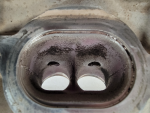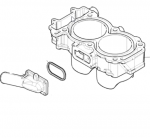OK, it's been a month. Finally getting my S**t together. Just now got the one video uploaded to YouTube successfully...I think...so here goes:
to start with, I have made contact with Terry Gilomen in the past with regard to hard starting. Since that ride, the first week of November, 2019, we were in Moab. Terry recommended finding
"winterized fuel" somewhere and use it. Terry told me winterized fuel has more butane in it, which combusts more easily an more quickly. So I found a station with big banners saying "We have Winterized gasoline". Sure enough, that put an end to hard starts. But come 2021, its hard to start the machine first start of the morning every time we go riding. So now what?
I made contact with my friend Terry Gilomen once again. His suggestion was, maybe it's time to do a leak down test and see what's going on in the cylinders. Phooey. I have a Snap On compression test tool kit, with fittings to pressurize a cylinder to remove valve spring keepers, etc. But not do leak down testing. So down to Harbor Freight and got a Maddox leak test kit. Not the best, but it works
well enough.
Set it up on the Right, or Passenger side, cylinder. It doesn't hold pressure at all. Starts bleeding down very quickly. Listening closely I can hear air blowing past something and out of cylinder. Pressure bleeds off from 100 psi to zero in less than a minute.
Set the Maddox kit up on the Left, or Driver side, cylinder. It bleeds down from 100 psi and holds at 40 psi.
Sent the results to Terry. Yup, time for a top end. Well, the dealership nearest to me sells several brands of machines and the Service Techs work on all of them. So how well will they perform doing a top end on the Pirate's General. I spoke with Terry and he said they could do it for me if I brought it to Northfield, Minnesota. Let's see, Basecamp tells me that's 1001 miles. History tells me that's where the James, Younger gang failed in a bank robbery attempt and got shot up. So something to do while the top end work is being done. I'll make the drive! Arrived there Mid-afternoon on a Tuesday. Stopped in about 9:30 Wednesday morning and the top end is disassembled and the root cause exposed.
Here is a YouTube video that shows the root cause. The exhaust valve guides are very loose. In the 8 second video you will see just how loose they are.
(this is the first video I have uploaded in a very long time, so bear with me if I messed it up. Plus the Filmora program has changed a lot too!)
Let's take a better look at the As Found condition of things: The Motor has 8974 miles at the time of the top end being rebuilt. As of this writing it has about 300 feet more.
Here is an overall look at the old cylinder head as it came off the engine. Terry said the black deposits on the flat surface of the head were to be expected. The Head Gasket was sealed
and not leaking. On the other hand, neither of us had an answer for the pink coloring in the intake ports. Are only thoughts were something in the 87 Octane mid-grade fuel I'm using.
I do have three 10.5 gallon Flo-Fast plastic containers and use a Flo-Fast pump to fill the fuel tank. So typically all the fuel comes from the Conoco-Phillips station closest to home.
Terry Gilomen suspected it might be valve guides. Does not have the shop equipment to replace them.
So Terry had a line on a new, bare Polaris cylinder head. It was ordered Wednesday morning first thing and
delivered Thursday morning before 8AM.
Here is a look at the intake ports on the old cylinder head:
As you can see the Intake ports have the pinkish coloring, but no signs of the "mud" of dust and gasoline.
A clear sign that road dust has not gotten through the Outerwears over the "combustion air intake" under
the hood. Has not gotten through the Outerwears over the Polaris air filter element in the air box. Has not
gotten through the Polaris air filter element. All excellent findings!!
One more thing to note here, the "port" at center and below the intake ports is the Cooling Water Outlet.
It's in the Cylinder Head. I'll be danged if I can find the aluminum casting that bolts to the head and the
upper radiator hose connects to it. I just don't think it's a part on any of the parts fiche page.
Here are pics of the exhaust ports. The both look the same. Nice and clean. Some small black deposits.
The pinkish deposits. but overall looking very good! But the black deposits aren't something I can scrape
off with a fingernail.
One can see some casting remnants at the mid-line of the ports. If I had the new bare head and a day,
I would have use abrasive tubes and ground them off and use some very fine polishing paste and a
fine abrasive tubes on a die grinder an polished the ports up a bit. Worth a bit in exhaust flow.
Here's a photo of the cylinders as removed from the engine:
If you look closely, you can see that there is a fair amount of the factory hone cross hatch pattern still in
the cylinders. Around the cylinders you can see the water jacket that keeps the cylinders cool when the
engine is running. All looks very good and the cylinder bores were given a light honing, the old gasket material
cleaned off. The cylinder cleaned and prepped for reassembly.
Also note that I have annotated the pic with the location of the Cooling Water Inlet Boss. The graphic below shows
the aluminum casting that bolts to the Cylinder Head bringing "cold" coolant to the engine from the lower radiator
hose.
As long as we're on the Cooling System. Might as well complete the discussion. Terry Gilomen told me the tops of the pistons looks just as he would
expect. Sadly when I arrived at the shop on Thursday morning the engine was completely assembled. So I can't you if the piston tops were cleaned or
not.
Here's something the Pirate learned in putting this post together. Digging through the parts fiche pages. See that dirty rectangular thing to the right
of the oil filter. With what are hoses coming out the front of it. Yeah, those two hoses that make access to the oil filter a real PITA?
That is the "Oil Cooler". I didn't know this engine had an oil cooler.
Looking at the greyed out graphic above, one can see the two hoses from the Oil Cooler running down to the Water Pump
Never having had my hands on a disassembled Crankcase. I'm not sure how the Oil Cooler circulation works. But I wonder,
Does the oil pump scavenge oil from the pan pump it up through the crankcase passages, then into the oil filter, out of the
oil filter, then into the oil cooler, out of the oil filter and to the engine oil passages.
Then the Coolant goes into the Oil Cooler, into the Crankcase, circulates to the left and out of the Oil Cooler. Thus the heat
exchange is taking place over about a 3 inch long Coolant passage inside an Oil passage? Someone jump in here if you have
the facts and hopefully pics.
Well, the Pirate has maxed out the number of pics that I can insert in a Post. So I will end this one and
start another post with the rest of doing a Top End Rebuild on a Polaris General 1000 Engine.
I'm interested in your comments. As you will read, there are a number of things I learned in this project.
More to come.
Pirate







